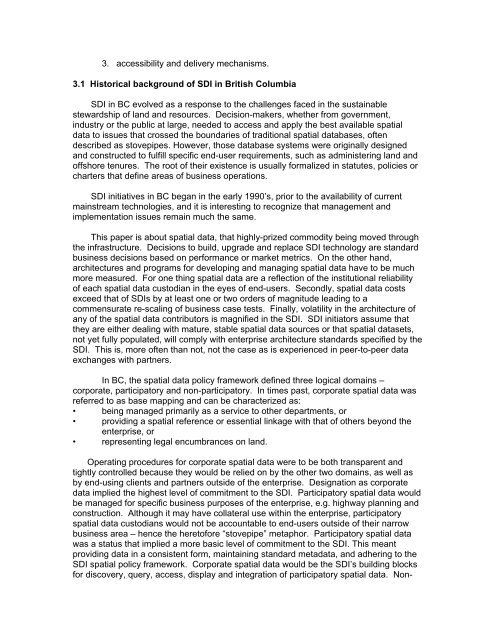paper - Global Spatial Data Infrastructure Association
paper - Global Spatial Data Infrastructure Association
paper - Global Spatial Data Infrastructure Association
Create successful ePaper yourself
Turn your PDF publications into a flip-book with our unique Google optimized e-Paper software.
3. accessibility and delivery mechanisms.<br />
3.1 Historical background of SDI in British Columbia<br />
SDI in BC evolved as a response to the challenges faced in the sustainable<br />
stewardship of land and resources. Decision-makers, whether from government,<br />
industry or the public at large, needed to access and apply the best available spatial<br />
data to issues that crossed the boundaries of traditional spatial databases, often<br />
described as stovepipes. However, those database systems were originally designed<br />
and constructed to fulfill specific end-user requirements, such as administering land and<br />
offshore tenures. The root of their existence is usually formalized in statutes, policies or<br />
charters that define areas of business operations.<br />
SDI initiatives in BC began in the early 1990’s, prior to the availability of current<br />
mainstream technologies, and it is interesting to recognize that management and<br />
implementation issues remain much the same.<br />
This <strong>paper</strong> is about spatial data, that highly-prized commodity being moved through<br />
the infrastructure. Decisions to build, upgrade and replace SDI technology are standard<br />
business decisions based on performance or market metrics. On the other hand,<br />
architectures and programs for developing and managing spatial data have to be much<br />
more measured. For one thing spatial data are a reflection of the institutional reliability<br />
of each spatial data custodian in the eyes of end-users. Secondly, spatial data costs<br />
exceed that of SDIs by at least one or two orders of magnitude leading to a<br />
commensurate re-scaling of business case tests. Finally, volatility in the architecture of<br />
any of the spatial data contributors is magnified in the SDI. SDI initiators assume that<br />
they are either dealing with mature, stable spatial data sources or that spatial datasets,<br />
not yet fully populated, will comply with enterprise architecture standards specified by the<br />
SDI. This is, more often than not, not the case as is experienced in peer-to-peer data<br />
exchanges with partners.<br />
In BC, the spatial data policy framework defined three logical domains –<br />
corporate, participatory and non-participatory. In times past, corporate spatial data was<br />
referred to as base mapping and can be characterized as:<br />
• being managed primarily as a service to other departments, or<br />
• providing a spatial reference or essential linkage with that of others beyond the<br />
enterprise, or<br />
• representing legal encumbrances on land.<br />
Operating procedures for corporate spatial data were to be both transparent and<br />
tightly controlled because they would be relied on by the other two domains, as well as<br />
by end-using clients and partners outside of the enterprise. Designation as corporate<br />
data implied the highest level of commitment to the SDI. Participatory spatial data would<br />
be managed for specific business purposes of the enterprise, e.g. highway planning and<br />
construction. Although it may have collateral use within the enterprise, participatory<br />
spatial data custodians would not be accountable to end-users outside of their narrow<br />
business area – hence the heretofore “stovepipe” metaphor. Participatory spatial data<br />
was a status that implied a more basic level of commitment to the SDI. This meant<br />
providing data in a consistent form, maintaining standard metadata, and adhering to the<br />
SDI spatial policy framework. Corporate spatial data would be the SDI’s building blocks<br />
for discovery, query, access, display and integration of participatory spatial data. Non-
















